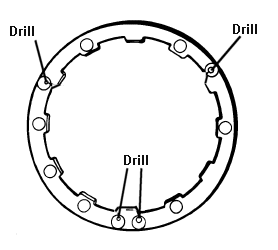Most "Do-It-Yourselfer" customers would not attempt to rebuild an Alpha lower. The special tools required to do this job right are expensive.
Extreme accuracy is required to build a drive that will last. The gears are spaced apart with the use of shims behind the bearing races. Precise measurements must be taken to insure exact clearances and one small error can destroy a new gearset.
We suggest that you purchase a Service Manual before attempting such a repair. Even our most experienced Merc techs still refer to the manual when building a drive.
Be Organized
There are a lot of internal parts in an Alpha lower. Roller bearings, shims, seals, washers, gears and shafts must all be kept in neat order as so you can keep track of the procedures that you are doing.
Use a good size work bench with large trays to place your parts in. It's good to have a "dirty parts" tray and a "clean parts" tray.
The work space needs to have a large vise, a stand to place the drive in, a hydraulic press and a parts washer.
It must be well lit and we recommend a good compressor with an air gun and air tools.
Be Clean
Make sure your shop area is CLEAN. Have all debris removed from the benches and floors.
Have an oil pan to catch an dripping oil of greasy parts. Keep a good supply of lint-free towels near by.
The Right Tools
You can not build the drive without the right tools.
Below is a list of tools required to build an Alpha One lower.
This tool is the best way to pull the carrier.

Trying to build an Alpha lower without even one of the above tools is almost impossible.
We also recommend a Pressure Tester to pressure test the drive after it is assembled. Pressure checking the drive is a very important part of the assembly procedure. Time and time again we find leaks in newly assembled drives.
As mentioned above, you will need some sort of drive stand. We use a drive stand made by Bob Kerr Tools. A complete Bob Kerr drive stand can cost well over $500.00. The stand is nice because you can rotate the drive into different positions. Otherwise, we have seen customers cut a "vee notch" in a work bench to slide the drive into. Whatever you use, it has to hold the drive FIRM and be strong.
You will be torqueing the rear cover nut to 250 ft lbs. so it needs to be right.
You will also need a good set of standard sockets, wrenches and screwdrivers, dead blow hammer and a long .025" feeler gauge.
